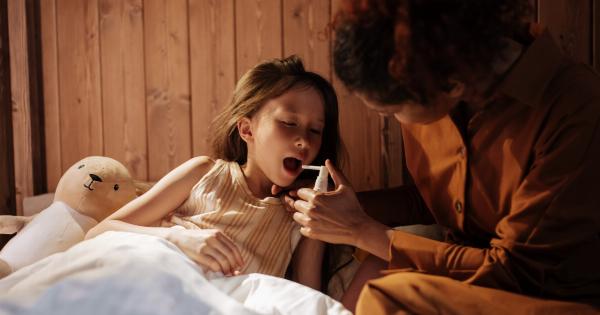Pediatric tonsillitis is a common childhood illness characterized by the inflammation of the tonsils. The tonsils are two small glands located at the back of the throat, which play a crucial role in the immune system, particularly during childhood.
When the tonsils become infected or inflamed, it can lead to uncomfortable symptoms and may require medical intervention.
Causes of Pediatric Tonsillitis
There are several causes of pediatric tonsillitis, including:.
1. Bacterial Infections: The most common cause of pediatric tonsillitis is a bacterial infection, most commonly caused by the group A Streptococcus bacteria. This type of infection is known as strep throat.
Other bacterial strains can also cause tonsillitis.
2. Viral Infections: Viruses such as the common cold virus or the Epstein-Barr virus can also lead to tonsillitis in children. Viral tonsillitis is generally less severe than bacterial tonsillitis but can still cause discomfort and throat pain.
3. Allergies: In some cases, pediatric tonsillitis may be triggered by allergies. The exposure to allergens can lead to inflammation and infection of the tonsils.
4. Other Factors: Other factors that can contribute to tonsillitis in children include smoking exposure, poor air quality, and close contact with individuals who have a throat infection.
Symptoms of Pediatric Tonsillitis
Children with tonsillitis may experience various symptoms, including:.
1. Sore Throat: One of the primary symptoms of pediatric tonsillitis is a sore throat. The throat may feel scratchy or painful, making it uncomfortable for the child to swallow.
2. Red and Swollen Tonsils: Inflamed tonsils are a clear indication of tonsillitis. The tonsils may appear red and swollen, and sometimes coated with a white or yellowish layer.
This visual symptom can help differentiate tonsillitis from other throat infections.
3. Difficulty Swallowing: Due to the soreness and inflammation, children with tonsillitis may have difficulty swallowing, leading to decreased appetite and potential weight loss.
4. Fever and Chills: Many cases of pediatric tonsillitis are accompanied by a fever. The child may also experience chills and fatigue.
5. Bad Breath: The presence of an infection in the tonsils can cause bad breath or a foul taste in the mouth.
6. Headaches and Earaches: Some children with tonsillitis may also complain of headaches or earaches.
7. Enlarged Lymph Nodes: Swollen lymph nodes in the neck can be another symptom of tonsillitis.
8. Voice Changes: In some cases, children with tonsillitis may experience a change in their voice. Their voice may sound muffled or nasal.
Diagnosing Pediatric Tonsillitis
If pediatric tonsillitis is suspected, a medical professional will perform a physical examination of the child’s throat and ask about the symptoms.
They may also take a throat swab to determine if the cause of the tonsillitis is bacterial or viral.
In some cases, additional tests such as blood tests or a throat culture may be necessary to confirm the diagnosis and rule out other potential causes.
Treatment Options for Pediatric Tonsillitis
The appropriate treatment for pediatric tonsillitis will depend on the underlying cause and the severity of the symptoms. Some common treatment options include:.
1. Antibiotics: If the tonsillitis is caused by a bacterial infection, antibiotics will be prescribed to help clear the infection. It is essential to complete the full course of antibiotics as prescribed by the healthcare professional.
2. Pain Relief: Over-the-counter pain relievers, such as acetaminophen or ibuprofen, can help reduce throat pain and fever. However, it is crucial to consult a healthcare professional before giving any medications to children.
3. Fluids and Rest: Encouraging the child to rest and drink plenty of fluids can help alleviate symptoms and support the healing process.
4. Warm Saltwater Gargles: Gargling with warm saltwater can provide temporary relief from throat discomfort and help reduce inflammation.
5. Surgical Intervention: In severe or recurrent cases of tonsillitis, where conservative measures fail to provide relief, a surgical intervention known as tonsillectomy may be recommended.
Tonsillectomy involves the removal of the tonsils and is considered a safe and effective procedure.
Preventing Pediatric Tonsillitis
While it is not always possible to prevent pediatric tonsillitis, some strategies may help reduce the risk of infection. These include:.
1. Good Hand Hygiene: Encouraging children to wash their hands regularly with soap and water can help reduce the spread of bacteria and viruses.
2. Avoiding Close Contact: Limiting exposure to individuals with a known throat infection can minimize the risk of transmission.
3. Maintaining a Healthy Lifestyle: Ensuring children have a balanced diet, get adequate sleep, and engage in regular physical activity can support a healthy immune system and reduce the likelihood of infections.
4. Managing Allergies: If a child has known allergies, taking steps to manage and minimize exposure to allergens can help prevent allergies triggering tonsillitis.
Conclusion
Pediatric tonsillitis is a common childhood illness that can cause significant discomfort and throat pain. It is essential for parents and caregivers to recognize the signs and symptoms of tonsillitis to seek appropriate medical attention.
Understanding the causes and treatment options can help manage the condition effectively and support the child’s recovery.





























